Planraum – Denkmodell
Ich thematisiere mit dem Projekt das Verhältnis zwischen
Denkraum (Planraum) und Zustandsraum. Der Begriff Denkraum bezeichnet
den gedanklichen nicht physikalischen Raum, in dem nach ausgewählten
Regeln Aktionen – nicht explizite Zustände - behandelt werden.
Der Begriff Zustandsraum bezeichnet das, was im Moment des Planens/Denkens
mit den Sinnen wahrgenommen werden kann. Der Zustandsraum hat immer
Einfluss auf den Denkraum und der Denkraum hat dann Einfluss auf den
Zustandsraum, wenn die Ergebnisse des Denkens in Handlungen umgesetzt
werden, die Folgen im Zustandraum haben. Der Denkraum ist unendlich
während der Zustandraum endlich ist. Man kann sich immer entscheiden,
entweder vom Zustandsraum oder vom Denkraum auszugehen. –(Mit
dem entwickelten Zustandsraum-Modell können Phasen des Denkens
im Zustandsraum, operational und im Prozess, in Entsprechung zu dem
was im Denkraum geschieht in einzelnen, kleinen Schritten – dort
in Zuständen - festgehalten werden.)
Mit der Theoriearbeit „künstliches Denken“ habe ich
allgemein zutreffende Kanten des planerischen Denkens in Regeln umgelegt,
die nahezu jedes Denken zulassen. Aus diesen entstand das Designobjekt
für den Zustandraum.
Dieses Objekt, das dreidimensionale Visualisierung ermöglicht,
befindet sich im Zustandsraum und repräsentiert eine mögliche
Weise den Denkraum zu entwickeln oder zu verwenden. Es fungiert als
reflexiver Bezugspunkt. Denkraum und Planraum können sich so auf
einer Ebene annähern.
Mit dem Projekt möchte ich ein Werkzeug an die Hand geben mit dem
Denkräume entwickelt und Denkwege nachvollzogen werden können
oder anhand dessen man sich beim planerischen Denken orientieren kann
– einzeln oder zu mehreren. Auf dieser Grundlage können eigene
Logik und Syntax für ein eigenes Denkmodell programmatisch entwickelt
werden. Das Denkmodell im Zustandsraum ist ein Designobjekt, das nach
meinen Untersuchungen die Strukturen des Denkens und seine Offenheiten
im Zustandsraum annähernd nachbildet und physisch erfahrbar macht.
Denkschemen, Denkstrukturen oder Denkmodelle, also das was ich u.a.
künstliches Denken nenne, können über diesen Punkt (re)flexiv,
auch von einer Gruppe, angewandt werden oder wirken.
Künstliches Denken
Anhand eines nicht elektrischen Modells, das den strukturellen Aufbau
des Gehirns nachahmt, einer Prozessumgebung für das Denken, können
eigene Denkabläufe bis ins Kleinste, einzeln oder in Gruppen, hergestellt
und überprüft werden. Die Ausstellung gibt einen Überblick
über den Stand der Entwicklung.
Niemals gab es eine ausgeprägte Alltagskultur des Denkens. In der
Antike, dem Zeitabschnitt, in dem ein wichtiger Grundstein für
unsere heutigen Denkformen gelegt wurde, gab es neben der Gymnastik
noch eine Forderung nach einem Minimum an Wissen über Grammatik
und Musik (5. Jh.). Der Umgang mit dem Phänomen „Denken“
reicht historisch von der Regelung durch Gesetze (Symmetrie und Balance
bei den Ägyptern) über Gleichgültigkeit in der Zeit der
Vorsokratiker bis hin zum Verbot eigenen Denkens von Untergebenen in
hierarchisch geordneten Gesellschaftsformen (welches immer parallel
existent war). Durch das computative Zeitalter und die damit einhergehende
Globalisierung herbeigeführt wird das eigene Denken wichtiger.
Es entwickelt sich zum einzigen Zugang zu allem. Ein Generalistentum
ist im Begriff, sich wieder auszubilden. In der Zeit, in der Sprache
etabliert ist und schon im Begriff zu inflationieren, ist Sprache noch
immer das Wichtigste und am weitesten Verbreitete, was zur Ausbildung
eines Denkens beiträgt. Sie ist aber nicht mehr das alleinig Ausschlaggebende,
das Denken ausbildende Faktum (Trigger), sondern nur noch Vehikel. Alle
Mittel, die das Denken anstoßen, beginnen das Denken auszubilden
- vor allem auch bildnerische.
Dass in ihren Elementen gleichbleibende Apparate es vermögen, das
Denken einzustellen und zu verstellen, ist am Gebrauch von mehr oder
weniger verbreiteten, kulturell entwickelten Gegenständen zu erkennen.
Sind sie weiter verbreitet, kommen einheitliche kulturelle Abläufe
und Handlungen und somit auch synchrone Lebensläufe zustande. Daraus
lässt sich schließen, dass sich auf Grund der Gleichheit
der Geräte annähernd ähnelnde formale Denkstrukturen/-modelle
(hier frei von Inhalten [also physischen Objekten und der Vorstellung
von diesen] betrachtet, aber natürlich anhand dieser sich entwickelnd)
ausbilden konnten. Nicht etwa nur solche übereinstimmenden Einstellungen
des Denkens, sondern solche und jene, die neben Anderen benutzt werden
konnten. Nicht etablierte neben etablierten. Trügerisch ist die
Empfindung, dass nicht übereinstimmende, also asynchrone Denkstrukturen/-modelle
unwichtiger wären als synchrone.
Durch die Erforschung der Künstlichen Intelligenz (die wiederum
ihre Vorbilder in der Geschichte der Produktionsmaschinen sucht (Zuse))
ist der Umgang mit Rechenmaschinen eingelassen in seine sinnstiftende
Monade. Die Vision von Künstlicher Intelligenz beeinflusst die
Art und Weise, wie geforscht wird und welche Ausrichtung die Forschungsarbeit
bekommt. Über diese Treppe manifestieren und bilden sich die formale
Mechanik und die Abläufe des »gedachten« Denkens (ob
bewusst oder unbewusst spielt hier keine Rolle) als Kulturtechniken
des Denkens in den Vorstellungen.
In der Tradition der Erforschung von Künstlicher Intelligenz wurde
gänzlich außer Acht gelassen, dass es Intelligenz ist, die
ausgelagert/delegiert wird (an Automaten, und damit wird sie in einem
Endstadium künstlich) und nicht Denken. Damit wurde der Fokus zu
eng gewählt, das Denken und die Erforschung seiner Formalitäten
und Nichtformalitäten vernachlässigt - Davon abgesehen wurde
aber Denken trotzdem, mit der Erforschung und Entwicklung von (Künstlicher)
Intelligenz einhergehend, zum wichtigeren Mittel, zur wichtigeren Fähigkeit
des Kognitiven erhoben, allerdings auf der Maschinenseite vernachlässigt.
Dieses Verhältnis verlangt nach der Disziplin des Künstlichen
Denkens. Es gibt einen Bedarf. Intelligenz (Intelligentes) kann dann
als (Neben)Produkt des Denkens angesehen werden, und bleibt nicht zwingend
das Maß aller Dinge oder schlagendes Argument für Kategorisierungen..
Das der Kommunikation von Schrift und Sprache Zugrundeliegende, die
Interaktion und - in Verbindung damit - ein unablässiges (Fort)Bewegen
des Stehenden (Fixen), sind Grundlage und erkenntnistheoretische Voraussetzung
für den Umgang mit dem Denken. Sprache dient also auch mir als
Vehikel. Doch nach dem oben Stehenden befinden wir uns, wenn man so
will, auf dem Boden, auf dem Sprache durch eine sie anziehende Schwerkraft
verhaftet ist. Hier angekommen, kann man beginnen, die Kräfte und
Kräfteverhältnisse, ja sogar den Boden zu verändern.
So beginnen wir, uns bei Erkenntnissen von der hermetisierenden Determination,
die Sprache oder Kommunikationsmittel im allgemeinen aufgrund ihrer
hohen Abstraktionsgrade liefern, zu lösen. Auf bisher nicht kommunizierbaren
Wegen zu wandeln. Neue und klein bleibende – nur ein paar werden
epochal gesehen groß – Kommunikationsmodelle zu entwickeln,
die sich auch hermetisieren, aber Mischformen und Eigensinniges lesbar
machen.
Um solcherlei kommunizierbar zu machen, ist es nötig, Vorstellungen
zu produzieren – im eigentlichen Sinne und auch im materiell realisierten
Sinne –, um sie über diese Instanz zu kommunizieren. Mein
Modell mit seiner Methode ist eines von dieser Art. Ein holovisueller
Ansatz, den es ins Holographische, besser – aus einer konstruktivistischen
Perspektive gesehen – Holosynästhetische zu überführen
gilt (ich bastardisiere hier den Begriff Holographie). Ich möchte
ein Werkzeug schaffen, das es nach dem heutigen Forschungsstand ermöglicht,
Denken beliebig anfassbar zu machen, auf eine Weise, dass man folgen
kann. Ein Werkzeug, auf das man all seine erlernten und anerzogenen
Theorien und Systeme anwenden kann. Auf dem man sie überprüfen
und Fallbeispiele durchspielen kann, sodass man sie ein- und ausschalten
könne.
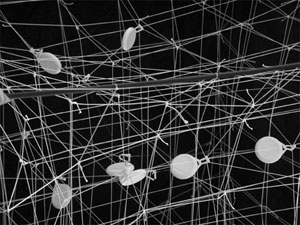
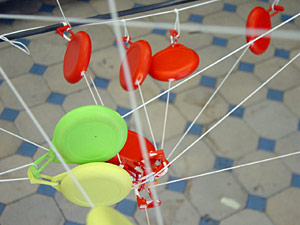
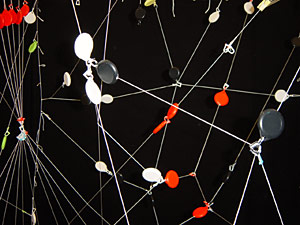
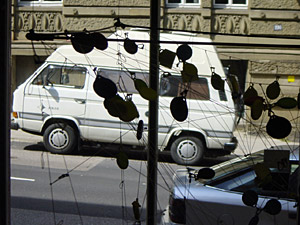
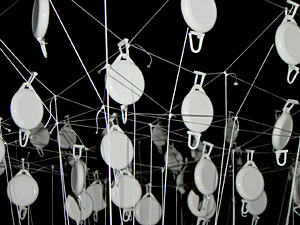
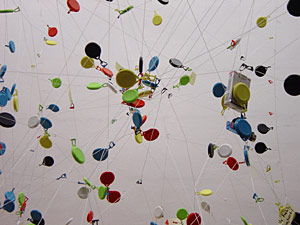
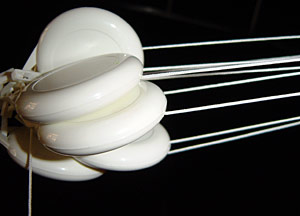
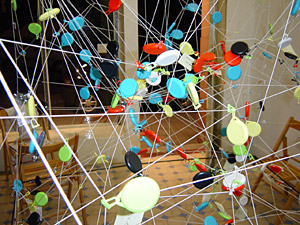
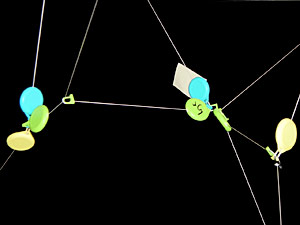
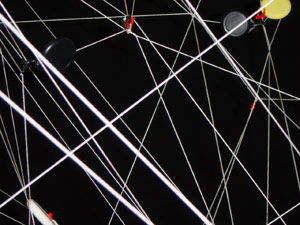
Hoch dynamischer nicht linearer Relationaler Prozessorraum
Eine Untersuchung zum Programmatischen
(english)
High dynamic, non linear, relational processor space
An inquary into programmatic
This project investigates the relationship between thinking space (conceptual space) and actual space. “Thinking Space” describes the thought space, the non-physical space, in which actions – non-explicit states – are explored according to selected rules. “Actual Space” describes the space, which, in the moment of planning/thinking, can be perceived by the senses. Actual space always influences thinking space, and thinking space influences actual space when the results of thinking are transformed into actions which affect actual space. Thinking space is infinite whereas actual space is finite. We can always decide whether to start out from actual or thinking space (with the here developed model of actual space, phases of thinking, whether in operation or in process, and reflecting the discrete, small steps which take place in thinking space, can be captured as conditions in actual space).
In the theoretical work “Artificial Thinking” I have transformed generally applicable parameters of conceptual thinking into rules which allow almost every kind of thought. From this emerged the designed object for actual space.
This object, that enables three-dimensional visualization, is found in actual space and represents a possible way of developing and using thinking space. It functions as a point of reflection or reference. It provides a level upon which thinking space and conceptual space can approach one another.
My aim in this project is to provide a tool which can be used to develop thinking spaces and trace paths of thought, or which can be used as a point of orientation in conceptual thinking – when working alone or in a group. Using this as a base, an individual logic and syntax for an individual thinking model can be programmatically developed. The thinking model in actual space is a designed object, which, according to my investigations, approximately reproduces the structure of thinking and its openings into actual space and allows this to be physically experienced. Thinking patterns, thinking structures or thinking models, that which I call artificial thinking, are reflected back over this point and re(used) by the individual or group, or they are allowed to become active.
Artificial Thinking (translation by J. Einfalt)
Based on a non-electric physical model, imitating the structural construction
(structure) of brains, a processing environment for thinking allows
to produce and verify own courses of thinking, up to the smallest degree
of its details (i.e. Elements and Parameters). This may happen in a
group-situation or by a single person.
There never was a distinct every day life culture of thinking. In the
ancient world, in the age when an important foundation was laid for
today’s thinking, a demand existed for a minimal knowledge of
grammar and music in addition to gymnastics (5th century). The preoccupation
with the phenomenon of thinking ranges from “ruled by laws”
(symmetry and balance with the Egypts in the 5 th century), unimportant
with the pre-Socratic philosophers, to a ban of autonomous thinking
by subordinates in hierarchical forms of society (which has been in
existence ever since). Brought about by the computer era and the accompanying
globalisation, self-dependent thinking is becoming more and more important.
It is evolving into the exclusive means of access to all and everything.
Once again, the emergence of generalists can be observed. In this age,
where speech is established and inflationarily spread at the same time,
speech is still the driving force behind the development, the education
and the cultivation of thinking. But it is not the sole most important
force anymore; it rather works only as a vehicle. All of the means that
push thinking begin to develop thinking – that is, primarily pictorial
means.
That apparatuses, being unchanged in their composition, own the power
to adjust and variate/shift thinking, can be recognised by the use of
more or less widely spread, culturally developed objects. When they
are widely spread, uniform cultural rituals, behaviours, and also synchronous
curricula vitae emerge. Consequently, similar structures of thinking/courses
of thinking/models of thinking were able to grow because of the similarity
of the pieces of the apparatuses (structures of thinking, courses of
thinking or thinking models mentioned here are regarded as being free
of content. Content is seen in physical objects and the imagination
of them. They certainly are necessary for thought, but I don’t
look at them in the first instance). Not only congruent attitudes of
thinking, but also those that are used next to others. Non-established
ones alongside established ones. The special sentiment, that courses
of thinking not in line with widespread ones, i.e. non-established and
consequently asynchronous courses of thinking/structures of thinking/thinking
models, are less important than established ones, is deceptive.
Because of the exploration of artificial intelligence (focussing on
intelligence), the dealing with computers (finding their model in the
history of production machines (Zuse)) is embedded in its monad causing
its meaning. The vision of artificial intelligence influences the way
in which it gets explored and its direction. The formal mechanic and
the courses of the »thought« thinking (conscious or unconscious
does not matter here) become manifest in this and develop as a cultural
technique of the idea of thinking.
In the tradition of artificial intelligence research it has been completely
disregarded that it is not thinking but intelligence itself which is
delegated to machines (to automats, and thus, intelligence becomes artificial
in one last instance). By choosing such a narrow focus, thinking and
the exploration of its formalities and non-formalities has been neglected.
All the same, with the exploration and development of (artificial) intelligence,
thinking has been raised to a more important means; to a more important
ability of cognitive action, certainly neglectet on machine side. This
relationship requires the scientific discipline and the exploration
of (artificial) thinking. There is a demand. Intelligence may be seen
as a (by)product of thinking and will no more remain the measure of
all or substantial argument in the matter of classification in categories.
The basic principles of written and spoken communication, namely the
interaction and – relating to it – a permanent continuity
of standing still (fix), form the foundation and epistemological prerequisite
for dealing with thinking. I am using writing and speech as a vehicle,
too. With regard to the aforementioned, however, we are standing on
the same ground towards which writing and speech are gravitating. On
arrival you are able to vary and change the relations of powers, to
even change the ground. In a process of recognition, we begin to free
ourselves of the hermetic determination that comes with the high degree
of abstraction of writing, speech or any other means of communication.
To walk on paths that had not yet passable for communication. To develop
new small and large models of communication, which are hermetic too,
but allow mixing their forms and making readable obstinate things.
In order to be able to communicate something like that, it is necessary
to produce notions – in their original meaning and in the meaning
of production – to communicate them over this entity. My model
with its method is one of this kind. A holovisual approach, which is
to be transported into a holographic, more precise – seen from
a constructivist perspective – into a holosynaesthetic concept.
(I deliberately bastardise the concept of holography). I want to create
a tool, within the context of the current state of scientific research,
which makes thinking tangible in an easy-to-follow manner. A tool that
makes it possible to verify all of the theories and systems you have
acquired and learned. A tool on which you can test, verify, and go over
case-examples, and which enables you to switch them on and off.